
Olsynium is a genus of summer-dormant rhizomatous perennial flowering plants in the iris family Iridaceae, native to sunny hillsides in South America and western North America.

Orthrosanthus is a genus of flowering plants in the family Iridaceae first described as a genus in 1827. It is native to Australia, Mexico, Central and South America.
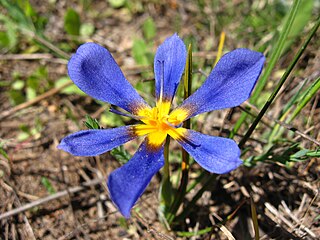
Calydorea is a small genus of perennial, herbaceous and bulbous plants in the family Iridaceae native to Mexico and South America. The plants in the genus are small with tunicated bulbs. The flowers are light blue, violet, white, or yellow, depending on the species, of which there are around twenty. Taxonomists considered that the already known genera Salpingostylis, Cardiostigma, Catila and Itysa are not enough different from each other to justify their taxonomic segregation and, for this reason, all of them are now included in Calydorea.

Cypella is a genus of herbaceous, perennial and bulbous plants in the family Iridaceae. It is distributed in South America, from Peru and Brazil to Northern Argentina. The genus name is likely derived from the Greek word kyphella, meaning "hollow of the ear", and alludes to the shape of the inner tepals.
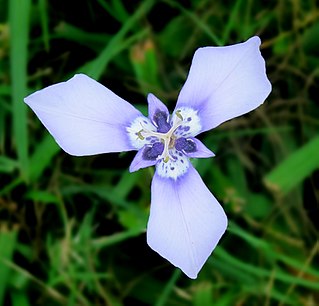
Herbertia is a small genus of herbaceous, perennial and bulbous plants in the family Iridaceae.

Cipura is a genus of perennial, herbaceous and bulbous plants in the family Iridaceae, related to the genus Cypella. The plants are widely distributed in Mexico, Central, the West Indies, and South America.
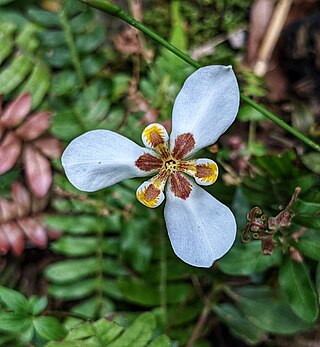
Hesperoxiphion is a genus of flowering plants in the family Iridaceae, first described as a genus in 1877. It is native to northwestern South America. The genus name is derived from the Greek words hesperos, meaning "western", and xiphos, meaning "sword".
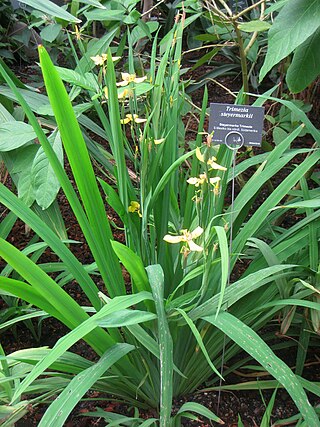
Trimezia is a genus of flowering plants in the family Iridaceae, native to the warmer parts of southern Mexico, Central America, South America, Florida, and the West Indies. Trimezia is placed in the tribe Trimezieae. The division of the tribe into genera has varied considerably. In one approach, it contains only the genus Trimezia, which then includes the genera Neomarica, Pseudotrimezia and Pseudiris. In other approaches, two to five genera are recognized, sometimes also including the genus Deluciris.
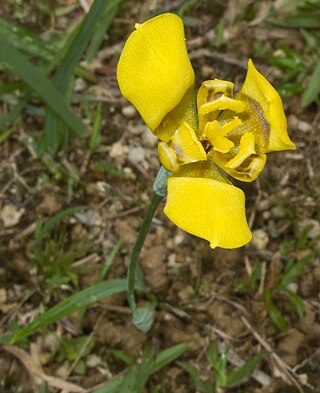
Trimezia martinicensis is a species of bulbous plant in the family Iridaceae. Originally from South America and the West Indies, it is now widely naturalized throughout the tropics. Common names include Martinique trimezia, yellow walking iris and forenoon yellow flag.

The North-West University Botanical Garden on the Potchefstroom Campus of the North-West University (NWU) is the only botanical garden in the North West Province of South Africa. The Garden spans just under three hectares and is open to the public.

Trimezia northiana, synonym Neomarica northiana, also known as North's false flag or walking iris, is a flowering plant, native to Brazil, with a rhizomatous rootstock, belonging to the iris family, Iridaceae.

Stenomesson is a genus of bulbous plants in the family Amaryllidaceae. All the species are native to western South America.
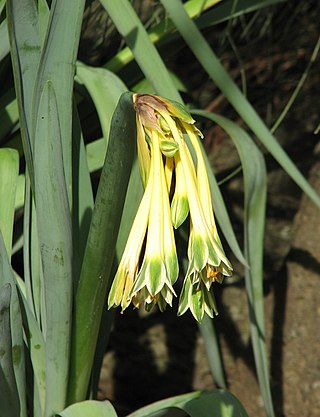
Clinanthus is a genus of bulbous plants in the family Amaryllidaceae. It is found in western South America, including Ecuador, Peru, Bolivia, north Chile and north west Argentina.

Miersia is a plant genus in the Amaryllidaceae. The genus has 10 known species, 9 of which are endemic to Chile and one, M. rusbyi, endemic to Bolivia.
Phalocallis is a genus of plants in the Iridaceae, first described as a genus in 1839. It contains only one recognized species, Phalocallis coelestis, native to Paraná State in southern Brazil, and also in northeastern Argentina.
Lethia umbellata is a species of flowering plants in the family Iridaceae first described in 1986. It is the only species in the monotypic genus of Lethia, and is native to Brazil and Bolivia.

Trimezia fosteriana is a species of bulbous plant in the family Iridaceae. Due to the attractive aspect of its leaves and exuberant and delicate yellow flowers, it is widely used in cities in South America for ornamental purposes and gardening. This species is easily confused with Trimezia longifolia, due to the similarity of its yellow flowers. However, the latter species, placed in the genus Neomarica by some sources, is distinguished by the presence of a flattened (leaf-like) flower stem.
Deluciris is a genus of flowering plant in the family Iridaceae, native to East Brazil. It was first described in 2018 by André Gil and Juliana Lovo.

Stylosanthes humilis, the Townsville stylo, is a species of flowering plant in the family Fabaceae, native to the New World Tropics, and widely introduced as a forage to the tropics of Africa, India, Southeast Asia, Malesia, and Australia. A nutritionally valuable forage plant, it was nearly wiped out in Australia in the 1970s by an outbreak of the fungus Colletotrichum gloeosporioides, which causes anthracnose disease.
















